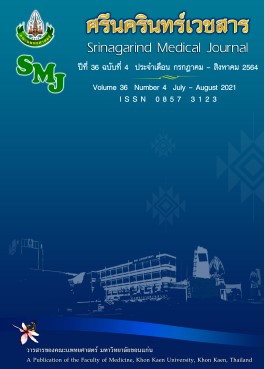ระดับความเสี่ยงการสัมผัสรังสีก่อไอออนต่อสุขภาพของบุคลากรสุขภาพที่ปฏิบัติงานในห้องปฏิบัติการสวนหัวใจและหลอดเลือด
คำสำคัญ:
รังสีก่อไอออน; ฟลูโอโรสโคปี; ห้องปฏิบัติการสวนหัวใจและหลอดเลือด; การประเมินความเสี่ยงบทคัดย่อ
หลักการและวัตถุประสงค์: รังสีก่อไอออนจากเครื่องฟลูโอโรสโคปีในห้องปฏิบัติการสวนหัวใจและหลอดเลือด (cardiac catheterization laboratory; cath lab) ส่งผลต่อสุขภาพบุคลากรสุขภาพ โดยเฉพาะอย่างยิ่งต้อกระจก ซึ่งเกิดได้มากกว่าบุคลากรสุขภาพด้านอื่น 2-4 เท่า หากไม่ได้ปฏิบัติตามแนวทางการทำงานสัมผัสรังสีที่ปลอดภัย การศึกษานี้มีวัตถุประสงค์เพื่อประเมินระดับความเสี่ยงการสัมผัสรังสีก่อไอออนของบุคลากรที่ปฏิบัติงานในห้อง cath lab
วิธีการศึกษา : การศึกษาเชิงพรรณนา กลุ่มตัวอย่างคือ บุคลากรที่ปฏิบัติงานในห้อง cath lab รพ. ศูนย์หัวใจสิริกิติ์ภาคตะวันออกเฉียงเหนือ จำนวน 16 คน เครื่องมือและข้อมูลใช้ในการศึกษาคือ 1) แบบ Semi-Quantitative 3x3 Matrix (SQM) 2) แบบ Radio-Protection Questionnaire (RPQ), และ 3) ข้อมูลระดับรังสีสะสมส่วนบุคคล วิเคราะห์ข้อมูลด้วยสถิติเชิงพรรณนา
ผลการศึกษา: บุคลากรมีระดับความเสี่ยงสูง ซึ่งประเมินจากความรุนแรงรังสีก่อไอออนระดับสูง ร่วมกับโอกาสสัมผัสระดับปานกลางโดยประเมินจากแบบ SQM พบว่า บุคลากรสัมผัสจำนวนมาก ความถี่การสัมผัสสูง สวมแว่นตาตะกั่วและการติดอุปกรณ์วัดรังสีส่วนบุคคลไม่ครบทุกคน และขาดการอบรมอย่างต่อเนื่อง แบบ RPQ จากบุคลากร 14 คน พบว่า มี 3 คน สวมแว่นตาตะกั่วทุกครั้ง มี 6 คน ติดอุปกรณ์วัดรังสีส่วนบุคคลทุกครั้ง และมี 1 คน ทราบระดับรังสีสมมูลของเลนส์ตาตนเอง
สรุป : บุคลากรสัมผัสรังสีก่อไอออนมีความเสี่ยงต่อสุขภาพในระดับสูง เนื่องจากระดับโอกาสสัมผัสปานกลาง (การสวมแว่นตาตะกั่วและการติดอุปกรณ์วัดรังสีส่วนบุคคลไม่ครบทุกคน ขาดการอบรมอย่างต่อเนื่อง) ร่วมกับผลต่อสุขภาพอยู่ในระดับรุนแรง
เอกสารอ้างอิง
2. Muirhead CR, Goodill AA, Haylock RG, Vokes J, Little MP, Jackson DA, et al. Occupational radiation exposure and mortality: second analysis of the National Registry for Radiation Workers. J Radiol Prot 1999; 19: 3–26.
3. Vaiserman A, Koliada A, Zabuga O, Socol Y. Health impacts of low-dose ionizing radiation: current scientific debates and regulatory issues. Dose Response [serial online] 2018 Sep 19 [cited Feb 4, 2020];16(3):[27 screens]. Available from: https://kku.world/jxip3
4. อภิเดช ชีวะประเสริฐ, วิโรจน์ เจียมจรัสรังษี. ความรู้และการปฏิบัติตนด้านความปลอดภัยจากรังสีในบุคลากรห้องปฏิบัติการสวนหัวใจของโรงพยาบาลรัฐในประเทศไทย. วารสารพยาบาลโรคหัวใจและทรวงอก 2562; 30: 32–45.
5. Awosan KJ, Ibrahim M, Saidu SA, Ma’aji SM, Danfulani M, Yunusa EU, et al. Knowledge of radiation hazards, radiation protection practices and clinical profile of health workers in a teaching hospital in Northern Nigeria. J Clin Diagn Res 2016; 10: LC07-12.
6. Soye JA, Paterson A. A survey of awareness of radiation dose among health professionals in Northern Ireland. Br J Radiol 2008; 81: 725–729.
7. Stewart FA, Akleyev AV, Hauer-Jensen M, Hendry JH, Kleiman NJ, Macvittie TJ, et al. ICRP publication 118: ICRP statement on tissue reactions and early and late effects of radiation in normal tissues and organs--threshold doses for tissue reactions in a radiation protection context. Ann ICRP 2012; 41: 1–322.
8. Cousins C, Miller DL, Bernardi G, Rehani MM, Schofield P, Vañó E, et al. ICRP publication 120: Radiological protection in cardiology. Ann ICRP 2013; 42: 1–125.
9. The 2007 Recommendations of the International Commission on Radiological Protection. ICRP publication 103. Ann ICRP 2007; 37: 1–332.
10. กฎกระทรวง กำหนดมาตรฐานในการบริหารและการจัดการด้านความปลอดภัย อาชีวอนามัย และสภาพแวดล้อมในการทำงานเกี่ยวกับรังสีชนิดก่อไอออน พ.ศ. 2547. ราชกิจจานุเบกษา 20 ส.ค. 2547; 121(ตอนที่ 52 ก): 16–25.
11. กฎกระทรวง ความปลอดภัยทางรังสี ความปลอดภัยทางรังสี พ.ศ. 2561. ราชกิจจานุเบกษา 5 ต.ค. 2561; 135(ตอนที่ 79 ก): 9–16.
12. Mahesh M. Fluoroscopy: patient radiation exposure issues. Radiographics 2001; 21: 1033–45.
13. Cornacchia S, Errico R, La Tegola L, Maldera A, Simeone G, Fusco V, et al. The new lens dose limit: implication for occupational radiation protection. Radiol Med 2019; 124: 728–35.
14. Elmaraezy A, Ebraheem Morra M, Tarek Mohammed A, Al-Habaa A, Elgebaly A, Abdelmotaleb Ghazy A, et al. Risk of cataract among interventional cardiologists and catheterization lab staff: a systematic review and meta-analysis. Catheter Cardiovasc Interv 2017; 90: 1–9.
15. Bitarafan Rajabi A, Noohi F, Hashemi H, Haghjoo M, Miraftab M, Yaghoobi N, et al. Ionizing radiation-induced cataract in interventional cardiology staff. Res Cardiovasc Med 2015; 4: e25148.
16. ศูนย์หัวใจสิริกิติ์ ภาคตะวันออกเฉียงเหนือ [ออนไลน์]. 2563 [อ้างเมื่อ 5 กุมภาพันธ์ 2563]. จาก: https://kku.world/m5lme
17. Erkan I, Yarenoglu A, Yukseloglu EH, Ulutin HC. The investigation of radiation safety awareness among healthcare workers in an education and research hospital. Int J Radiat Res 2019; 17: 455–61.
18. Rahman N, Dhakam S, Shafqut A, Qadir S, Tipoo FA. Knowledge and practice of radiation safety among invasive cardiologists. J Pak Med Assoc 2008; 58: 119–22.
19. Friedman AA, Ghani KR, Peabody JO, Jackson A, Trinh Q-D, Elder JS. Radiation safety knowledge and practices among urology residents and fellows: results of a nationwide survey. J Surg Educ 2013; 70: 224–31.
20. Padovani R, Le Heron J, Cruz-Suarez R, Duran A, Lefaure C, Miller DL, et al. International project on individual monitoring and radiation exposure levels in interventional cardiology. Radiat Prot Dosimetry 2011; 144: 437–41.




